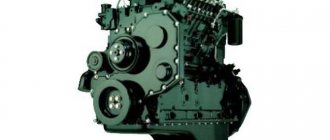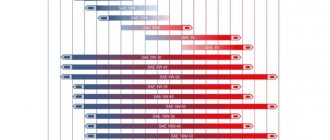ZIL-131 Fuel consumption Dimensions Load capacity Weight Tank volume
The three-axle ZIL-131 is the main model of the off-road truck of the Moscow Likhachev Plant from 1966 to 1994. This is one of the most famous and recognizable cars of the Soviet automobile industry throughout the world. “ZIL-131” is, first of all, a military vehicle, which for decades was supplied to the Soviet army and the armed forces of countries allied with the USSR.
ZIL-131 - video of off-road driving
Thanks to this prevalence not only in socialist states, but also in many, so to speak, “banana republics”, “ZIL-131”, unexpectedly for itself, made a long and successful film career in Hollywood.
In addition to dozens of films about James Bond and other numerous, lesser-known Cold War movie fighters, ZIL-131 has appeared more than once in modern foreign cinema.
In the same "Transformers", for example. Or in “The Expendables 2”: Sylvester Stallone and his “dream-team” of retro action stars famously burst into a military ZILka straight into the terrorists’ lair! At the same time, the creators of all these films, both old and new, during their filming never visited not only Russia, but even the CIS.
His element is off-road
"ZIL-131" is an all-wheel drive truck with a front-engine layout and a 6x6 wheel arrangement. Initially it was created as an all-terrain vehicle. For transporting goods and people, as well as for towing trailers - both on roads of all types and over rough terrain.
In the model range of the Likhachev Plant, the ZIL-131 replaced the no less famous, and even legendary, off-road vehicle ZIL-157.
In terms of cross-country ability, the ZIL-131 is not inferior even to tracked vehicles. This truck was created on the platform of its predecessor, the ZIL-157, which was significantly improved; equipped with an innovative bridge, eight-ply tires with a special tread pattern, and a center differential.
“ZIL-131” has proven itself to be an extremely durable machine for operation in any climatic conditions, including the Far North, tropical and equatorial latitudes, demonstrating stable and trouble-free operation at air temperatures from –45 to +55 °C.
About the history of the most popular ZIL SUV
While developing the ZIL-131, the designers of the Likhachev Plant successfully coped with the task of creating an off-road army truck that was inexpensive to produce, easy to operate and maximally unified with its “civilian counterpart.”
The first to be launched into mass production was a new mass-produced truck for the national economy - the ZIL-130; and three years after that - the army ZIL-131. However, less than five years later, from January 1971, it ceased to be a purely military vehicle and began to be mass produced as a simplified national economic truck - without the components characteristic of army vehicles.
The serial, “classic” ZIL-131 was produced for twenty years: from 1966 to 1986, when its modernized version, the ZIL-131N, was launched into production. This version was equipped with an improved engine (improved efficiency indicators, extended service life), more modern optics and an awning made of new synthetic materials.
A few years later, they began to try to equip the ZIL-131N not with carburetor, but with diesel engines: their own “ZIL-0550”; motors of others; YaMZ-236 and even Caterpillar.
However, the modernized 131st did not receive wide distribution, despite the fact that, in addition to the Likhachev plant, it was also produced at the Ural Automotive Plant until 2006. It’s just that production volumes were no longer the same. In the Urals, by the way, the ZIL-131N has been produced in recent years under the name Amur-521320.
The maximum level of production of 131 series trucks occurred in the 80s, when up to 48 thousand of these vehicles were produced per year. And the number of workers employed at ZIL by that time reached 120 thousand people. In total, the Likhachev Plant built 998,429 vehicles of the ZIL-131 family. The absolute majority of them, of course, were during the years of the USSR. And for the entire period 1987 – 2006, both enterprises assembled 52,349 cars of the updated modification - “ZIL-131N”.
The distribution of the load transmitted to the road from the mass of the equipped vehicle through the tires is: 27.5/30.45 kN (2750/3045 kgf) – front axle; 33.85/33.30 kN (3385/3330 kgf) – rear bogie.
The distribution of the load transmitted to the road from the total weight of the vehicle through the tires is equal to: 30.60/33.55 kN (3060/3355 kgf) – front axle; 71.25/70.70 kN (7125/7070 kgf) – rear bogie.
The overhang angle parameters are as follows: front without a winch - 45 degrees, with a winch - 36 degrees; rear - 40 degrees.
Engines
— The main, “native” engine of the serial “ZIL-131” is a 4-stroke eight-cylinder V-shaped 90° carburetor engine with a volume of 6 liters. Its rated power (with rev limiter) is 150 horsepower. The power unit belongs to the overhead valve type of engine, liquid cooled. The cylinder diameter is 100 mm; piston stroke – 95 mm. Compression ratio – 6.5. Torque – 41 kgf*m (410 Nm). Specific fuel consumption is at least 35-38 liters per 100 kilometers. Its considerable power needs are provided by two fuel tanks of 170 liters each.
— The 150-horsepower ZIL-5081 V8 engine, modernized in 1986, differs from the previous engine in cylinder heads with screw inlet ports and a compression ratio increased to 7.1. This engine was also slightly more economical than its predecessor.
— Diesels with which, already in its recent history, the ZIL-131 was equipped: “D-245.20” - an in-line four-cylinder diesel engine with a working volume of 4.75 liters. The rated power of this engine is 81 horsepower, the maximum torque reaches 29.6 kgm. Diesel fuel consumption is 18 liters per 100 km; YaMZ-236 is a six-cylinder V-shaped diesel engine with a volume of 11.15 liters. The rated power of this engine is 180 hp; own four-stroke diesel engine of the Likhachev plant “ZIL-0550” (6.28 l, 132 hp). However, the ZIL-131 diesel truck is still a rarity.
Frame and suspension of the ZIL-131 truck
The frame of the ZIL "SUV" is stamped, riveted, with channel-section spars, which are connected by stamped cross members. At the rear there is a hook with a rubber shock absorber; In front of the frame there are two rigid towing hooks.
Front suspension - on longitudinal springs; the front ends of the springs are fixed to the frame using lugs and pins, and the rear ends of the springs are “slippery”. The rear suspension is balanced, on two longitudinal springs. The shock absorbers (on the front suspension) are hydraulic, telescopic, double-acting.
The truck is equipped with disc wheels with 8-stud fastening. The front dependent suspension of the truck is installed on two semi-elliptic springs, equipped with shock absorbers and rear sliding ends. The rear suspension (balancer) is mounted on two semi-elliptic springs with sliding ends and 6 reaction bars.
Steering and brake control; transmission "ZIL-131"
The truck is equipped with a hydraulic power steering drive located in a common housing with the steering mechanism. The steering mechanism - the working pair - is a screw with a nut on circulating balls, and a rack that engages with a gear sector.
The power steering pump is a vane type, double acting, driven by a belt from the crankshaft pulley. The steering gear ratio is 20. The longitudinal and transverse steering rods are with heads on ball pins, with self-clamping nuts.
The brake mechanisms of the service brake system are drum type with two internal pads, unclenched by a fist, installed on all wheels. The brake drum diameter is 420 mm; pad width – 100 mm.
The total area of the brake linings is 4800 cm2. When the service brake system is turned on, the drive of the brake mechanisms is pneumatic, without separation along the axes. There are six brake chambers, type 16.
The brake mechanism of the parking brake system is a drum type with two internal shoes, unclenched by a fist, installed on the transmission shaft. The braking distance on a dry, asphalt, flat highway from a speed of 60 km/h is about 25 meters.
"ZIL-131" is equipped with a mechanical five-speed gearbox, with two inertial synchronizers for engaging second - third, fourth - fifth gears. Transfer case – mechanical, 2-speed (2.08:1 and 1:1); The main gear is double, with a pair of bevel (gear ratio 1.583) and a pair of cylindrical (gear ratio 4.25) gears. Cardan transmission is open type.
The clutch is single-plate, dry, with a spring-loaded torsional vibration damper (damper) on the driven disc. Friction linings are made of asbestos composition. The number of pairs of friction surfaces is 2.
Some modifications of the vehicle are equipped with a drum-type winch, complemented by a worm gearbox with a maximum traction force of 5000 kgf. The length of the winch cable is 65 meters.
Axles of the ZIL-131 truck
The beams of the driving axles are steel, welded from two stamped halves with welded flanges and a cover. The four cardan shafts are equipped with joints on needle bearings. The main gear is a two-stage drive of the rear axles (sequential, continuous).
The front axle drive is switched on automatically (by an electro-pneumatic valve) when the first (lower) gear is engaged in the transfer case; forced - when the second (direct) gear is engaged with a switch installed on the front panel of the cab.
When the front axle is turned on, a warning lamp on the instrument panel in the cockpit lights up. When starting, the downshift lever, which is part of the transfer case, forcibly turned on the pneumatic drive of the front axle.
"ZIL-131" is equipped with a contactless ignition system equipped with an electronic switch and an automobile generator of increased power. Additionally, there is an emergency generator, which allows, in the event of failure of the electronic switch, to move under its own power for about 30 hours, without a significant loss in dynamics.
Features of oil change in ZIL 131
The oil in the power unit of the 131st is changed according to the following algorithm:
When pouring liquid, you need to control the volume using a dipstick. It is recommended that the quantity be between the minimum and maximum. This is approximately 90% of the desired value. Then the chemistry can be topped up to the limit. Upon completion of work, check the volume again. This method helps not to overfill the oil and avoid underfilling it.
Despite the fact that the engine of this truck is reliable and unpretentious, it cannot be operated with insufficient volume or with old oil or filter. This reduces the service life of the motor and leads to the need for major repairs. Therefore, it is necessary to adhere to the prescribed replacement deadlines. When carrying out the procedure, it is necessary to install a new filter element.
Source
Cabin ZIL-131
The cabin is all-metal, three-seater, heat-insulated. The cabin is heated with water, from the engine cooling system, with a centrifugal fan. The heater duct damper control handle is located on the cab panel. Cabin ventilation is carried out through roll-down windows, rotary door vents and a duct in the right wing mudguard.
The seats in the cabin are separate. In this case, the driver's seat is adjustable, the passenger seat is double. The seat cushions are made of sponge rubber.
Loading platform and body of the basic ZIL-131
The ZIL-131 body is a wooden platform with a metal frame and metal transverse base bars. The front and side sides of the body are solid, the rear side is folding. The truck platform is adapted for transporting people: there are folding benches for 16 seats on the side rails, and there is also an additional middle removable bench for 8 seats. The body is covered with an awning on installed arches.
Fire truck on ZIL-131 chassis
How much oil to pour into the ZIL 130 engine
Array ( [DATE_ACTIVE_FROM] => 11/26/2020 03:30:00 [
DATE_ACTIVE_FROM] => 11/26/2020 03:30:00 [ID] => 509835095 [
ID] => 509835095 [NAME] => Oil volume in the ZIL 131 engine [
NAME] => Oil volume in the ZIL 131 engine [IBLOCK_ID] => 33 [
IBLOCK_ID] => 33 [IBLOCK_SECTION_ID] => [
IBLOCK_SECTION_ID] => [DETAIL_TEXT] => ZIL 131 is a truck created by the Likhachev Moscow Automobile Plant. Years of production: 1966-2002. The truck was distinguished by increased cross-country ability, so it was originally created for military purposes. Previously it had a body with a cargo platform made of wood. The tailgate can be folded back for convenience. Also based on the truck, tanks for transporting fuel, fire trucks with a tank and some other special vehicles for various purposes were produced. Now the car is not produced, but many copies of this model are still in use in a number of countries from around the world. ZIL was equipped primarily with a 6-liter gasoline engine with a power of 150 horsepower. Fuel consumption in the combined cycle is at least 35.5 liters per 100 kilometers. The maximum speed of a truck usually does not exceed 80 km/h. The manufacturer recommended AI-76 gasoline for this model. But today cars are usually filled with AI-80 fuel.
Modifications of ZIL-131
“ZIL-131” is the basic version, mass production of which lasted from 1966 to 1986.
“ZIL-131A” is a special version with unshielded electrical equipment. It differed from the basic modification in the absence of special military equipment, an average bench in the back and a searchlight.
"ZIL-131V" is a truck tractor developed on the basis of "ZIL-131". In this modification, the car’s frame was shortened; It was equipped with a fifth wheel coupling and two spare tires. The ZIL-131V tractor could transport a semi-trailer weighing 12 tons (on paved highways) or 10 tons (on dirt roads). Produced from 1968 to 1986.
"ZIL-131D" - dump truck. By the way, the same name was given to a rare and “exotic” version of the 131st ZIL in 1992, equipped with an imported Caterpillar diesel engine, which was produced in very modest quantities until 1994.
“ZIL-131S” and “ZIL-131AS” are trucks for the regions of the Far North, Siberia and the Far East. These modifications were equipped with a cabin with an autonomous heater, frost-resistant rubber products, additional thermal insulation, standard fog lights, battery insulation and double glass. Designed for use at temperatures up to -60 degrees. We gathered in Transbaikalia, at the Chita car assembly plant.
“ZIL-131X” is a version adapted for desert and tropical climates.
“ZIL-131N” is a version of the base model modernized in 1986. Innovations: improved ZIL-5081 V8 engine, with a resource increased to 250 thousand km, an awning made of more modern synthetic materials and improved optics.
“ZIL-131NA” is a version of ZIL-131N, equipped with unshielded electrical equipment.
"ZIL-131NV" is a truck tractor with an improved platform.
“ZIL-131N1” – modification with a 105-horsepower diesel engine “D-245.20”;
“ZIL-131N2” - version with a 132-horsepower diesel engine “ZIL-0550”;
“ZIL-131NS”, “ZIL-131NAS” and “ZIL-131NVS” - modified versions of the northern version;
"ZIL-131-137B" - road train.
Special vehicles based on ZIL-131
A significant volume of production was occupied by a universal chassis designed for mounting various superstructures and special equipment. In addition to the well-known fire trucks, the following were also produced on the ZIL-131 chassis:
— Fuel tanker trucks: “ATZ-3.4-131”, “ATZ-4.4-131”, “ATZ-4-131”; — Oil tankers: “MZ-131”; — Universal tank trucks: “ATs-4.0-131”, “ATs-4.3-131”. — Airfield mobile units (tractors): “APA-50M”; "APA-35-2V". It is interesting that these ZIL-131s serving in aviation had a total weight in excess of the officially permitted one: 10,950 and 11,370 tons, respectively.
For army versions of workshops, laboratories, mobile radio stations, command and staff vehicles, standard KUNG van bodies “K-131” and “KM-131” were developed. These KUNGs were equipped with a special filtration unit “FVUA-100N-12”. It takes air from the surrounding atmosphere and supplies it to the van, simultaneously disinfecting it.
Pump-Auto
| Filling/lubrication point | Volume, l | Name of material/liquid |
| Fuel tanks | 2x170 | Gasoline A-76 |
| Cooling system | 29 | Antifreeze A-40 (water allowed) |
| Engine lubrication system | 9 | All-season up to minus 30°C - oils M-6/10V (DV-ASZp-YuV) and M-8V, at temperatures below minus 30°C oil ASZp-6 (M-4/6V,) |
| Hydraulic steering system | 3,2 | Oil grade P |
| Gearbox (without power take-off) | 5,1 | All-season oil TSp-15K, at temperatures below minus 30°C oil TSp-10 |
| Transfer case | 3,3 | All-season oil TSp-15K, at temperatures below minus 30°C oil TSp-10 |
| Main gear housings for driving axles | 3×5,0 | All-season oil TSp-15K, at temperatures below minus 30°C oil TSp-10 |
| Winch gear housing | 2,4 | All-season oil TSp-15K, at temperatures below minus 30°C oil TSp-10 |
| Shock absorbers | 2×0,45 | Shock-absorbing fluid AZh-12T |
Reviews ZIL-131
According to reviews from drivers who have experience working with the ZIL-131, it is an extremely reliable, durable and “tenacious” car. And, of course, it has phenomenal cross-country ability. Which is capable of successfully making its way even with a fully loaded body along wet and broken field roads; and along clay slopes; and along sand dunes; and along the rough terrain blurred by heavy rains - “where tanks would get stuck.”
The presence of a downshift is very pleasing and helps out. Mechanical tire inflation works effectively, making it possible to adjust tire pressure for driving on various road and off-road surfaces (snow, wetlands, soil), “though you must remember to open the valves on the wheels.”
The driver’s car is simple, “almost the same 130.” The only difference is the cabin and the presence of a middle axle, as well as, of course, all-wheel drive. Excellent access for repairs and maintenance is available from all sides. Removing the engine is very simple.
The gasoline consumption of the ZIL-131, by today's standards, is simply mind-blowing and terrifying. However, in Soviet times this issue was not at all as pressing as it is now. Gasoline in the 70s cost 6 kopecks per liter. And who bought it for ZIL-131? There were no privately owned trucks back then. All of them belonged to the state and, accordingly, were refueled at its expense.
The cabin, of course, is very “Spartan”: you can immediately see that it is a working one, or a “soldier’s one”, and the list of amenities in it is minimal: “it’s good that the doors close, the glass is intact and the stove heats up!” “That’s all the convenience.” But the heater is excellent, “it works like a blast furnace”: in five/ten minutes you’re sitting as if in the tropics.
For long trips on the highway, the ZIL-131 is of little use: sitting in its cabin is hard, shaking, at speeds over 65 km/h - it’s already so noisy that you can hardly understand the words of your interlocutor.
The conclusion is simple: if on a normal asphalt road anyone would choose another truck, then where the road ends and rough terrain begins, few trucks can compete with the ZIL-131.
Prices for "ZIL-131"
There are many advertisements on the Internet for the sale of used ZIL-131 trucks of various options - flatbeds, dump trucks, fuel tankers; with a kung van.
The price range is wide: from 100 to 300 thousand rubles (depending on the technical condition) are asked for cars produced in the 70s-90s.
For those removed from conservation, with low mileage, they are much more expensive - from 500 to 700 and even 950 thousand (more economical diesel ones are more expensive). But some of these examples also look like “a hunter’s and traveler’s dream”: their kung van is well equipped and modified.
Features of oil change in ZIL 131
The oil in the power unit of the 131st is changed according to the following algorithm:
When pouring liquid, you need to control the volume using a dipstick. It is recommended that the quantity be between the minimum and maximum. This is approximately 90% of the desired value. Then the chemistry can be topped up to the limit. Upon completion of work, check the volume again. This method helps not to overfill the oil and avoid underfilling it.
Despite the fact that the engine of this truck is reliable and unpretentious, it cannot be operated with insufficient volume or with old oil or filter. This reduces the service life of the motor and leads to the need for major repairs. Therefore, it is necessary to adhere to the prescribed replacement deadlines. When carrying out the procedure, it is necessary to install a new filter element.
ZIL 131 is a truck created by the Likhachev Moscow Automobile Plant. Years of production: 1966-2002. The truck was distinguished by increased cross-country ability, so it was originally created for military purposes. Previously it had a body with a cargo platform made of wood. The tailgate can be folded back for convenience.
Also based on the truck, tanks for transporting fuel, fire trucks with a tank and some other special vehicles for various purposes were produced. Now the car is not produced, but many copies of this model are still in use in a number of countries from around the world.
ZIL was equipped primarily with a 6-liter gasoline engine with a power of 150 horsepower. Fuel consumption in the combined cycle is at least 35.5 liters per 100 kilometers. The maximum speed of a truck usually does not exceed 80 km/h. The manufacturer recommended AI-76 gasoline for this model. But today cars are usually filled with AI-80 fuel.
Technical characteristics of ZIL-131
— Wheel formula: 6×6
Engine ZIL-131
— ZIL-131, Volume: 5,969 cm3 — Maximum power: 150 hp, at 3200 rpm — Max. torque: 402 Nm, at 2000 rpm
Maximum speed ZIL-131
— 85 km/h
Fuel consumption ZIL-131
— Fuel consumption on a combined cycle: 49.5 l/100 km
Overall dimensions of ZIL-131
— Length: 7040 mm — Width: 2500 mm — Height: 2480 (with awning 2970) mm — Ground clearance: 330 mm — Wheelbase: 3350+1250 mm — Rear track: 1820 mm — Front track: 1820 mm — Gearbox: manual 5-speed - Transfer case: 2-speed
Load capacity of ZIL-131
— 3.5 tons on a dirt road
Weight ZIL-131
— Curb weight: 6135 kg (without winch) — Gross weight: 10 185 kg (without winch)
Tank volume ZIL-131
— 2×170 liters
Oil volume in the ZIL 131 engine
ZIL 131 is a truck created by the Likhachev Moscow Automobile Plant.
Years of production: 1966-2002. The truck was distinguished by increased cross-country ability, so it was originally created for military purposes. Previously it had a body with a cargo platform made of wood. The tailgate can be folded back for convenience. Also based on the truck, tanks for transporting fuel, fire trucks with a tank and some other special vehicles for various purposes were produced. Now the car is not produced, but many copies of this model are still in use in a number of countries from around the world.
ZIL was equipped primarily with a 6-liter gasoline engine with a power of 150 horsepower. Fuel consumption in the combined cycle is at least 35.5 liters per 100 kilometers. The maximum speed of a truck usually does not exceed 80 km/h. The manufacturer recommended AI-76 gasoline for this model. But today cars are usually filled with AI-80 fuel.



